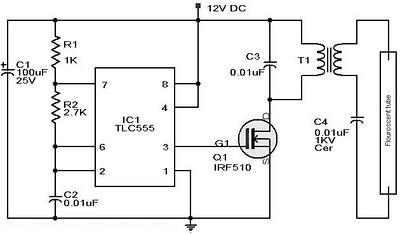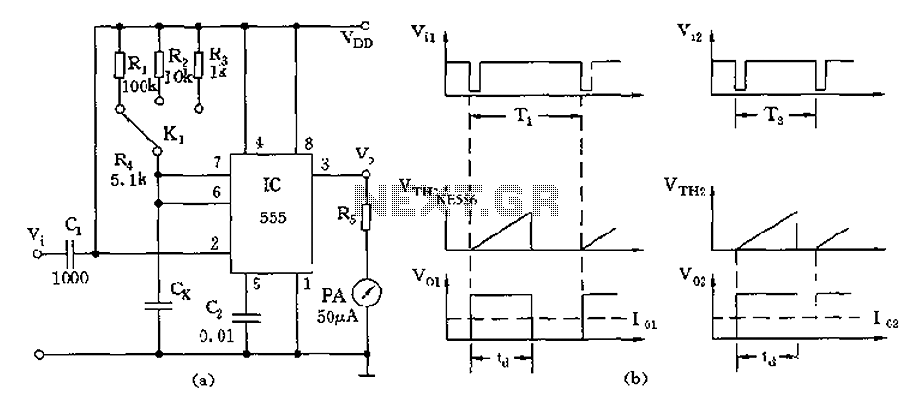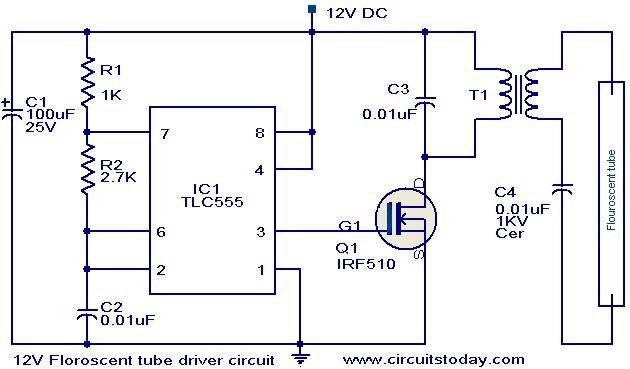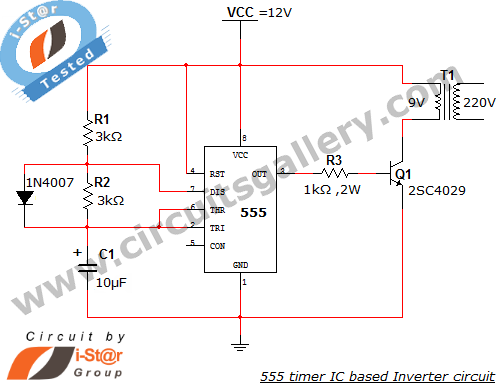
12vdc fluorescent lamp driver schematic

Whenever there is a need for battery-powered lighting, such as for camping, solar-powered cottages, cars, boats, planes, or emergency situations, fluorescent lamps are highly appealing. They are significantly more efficient than incandescent lamps, producing much more light for less power consumption. Additionally, their light color remains constant as the battery discharges. This article presents a driver circuit for a 12 V/5 Watt fluorescent lamp. The circuit utilizes a standard 220 to 10 V step-down transformer in reverse to convert 12 V to approximately 240 V, allowing the lamp to operate without the need for filament heating. The IC TLC 555 is configured as an astable multivibrator to generate the required oscillations. A MOSFET (Q1) amplifies these oscillations, and the output from the MOSFET is connected to the primary winding of the step-up transformer, generating approximately 240 V AC to drive the fluorescent lamp.
The described circuit provides an efficient solution for driving a 12 V fluorescent lamp, particularly in applications where battery power is essential. The utilization of a standard transformer in reverse allows for a straightforward approach to achieve high voltage from a low voltage source. The TLC 555 timer IC, known for its versatility, is configured in an astable mode, which enables it to produce a continuous square wave output. This output serves as the control signal for the MOSFET, which functions as a switch to modulate the current flowing through the primary winding of the transformer.
The choice of a MOSFET for amplification is critical, as it can handle higher frequencies and provides greater efficiency compared to bipolar junction transistors. The output from the MOSFET is coupled to the primary of the step-up transformer, which transforms the lower voltage input into a much higher AC voltage suitable for driving the fluorescent lamp. The design eliminates the need for a filament warm-up period, allowing for immediate illumination upon activation.
In practical applications, this circuit can be integrated into portable lighting systems, emergency lights, or off-grid solar-powered setups. The efficiency of fluorescent lamps combined with this driver circuit makes it an ideal choice for energy-conscious users seeking reliable lighting solutions in various environments. Proper consideration should be given to component ratings to ensure reliability and safety during operation, particularly in applications involving high voltage output.Whenever there is a need for battery-powered lighting, like for camping, solar powered cottages, cars, boats, planes, or emergency purposes, fluorescent lamps have a great appeal. Firstly, they are very much more efficient than glow lamps, so they produce much more light for less power consumption.
Secondly, their light color stays constant while the battery runs down. In this article I will offer driver circuit for 12 V/5Watt fluorescent lamp, this circuit used a normal 220 to 10V stepdown transformer in reverse to step 12V to about 240V to drive a lamp without the need to warm the filaments. The IC1 TLC 555 is wired as an astable multivibrator for producing the necessary oscillations. The MOSFET Q1 is used to amplify the oscillations produced by the IC1. The out put of MOSFET is connected to the primary of the step up transformer to produce a ~240 V AC for driving the florescent lamp.
🔗 External reference
The described circuit provides an efficient solution for driving a 12 V fluorescent lamp, particularly in applications where battery power is essential. The utilization of a standard transformer in reverse allows for a straightforward approach to achieve high voltage from a low voltage source. The TLC 555 timer IC, known for its versatility, is configured in an astable mode, which enables it to produce a continuous square wave output. This output serves as the control signal for the MOSFET, which functions as a switch to modulate the current flowing through the primary winding of the transformer.
The choice of a MOSFET for amplification is critical, as it can handle higher frequencies and provides greater efficiency compared to bipolar junction transistors. The output from the MOSFET is coupled to the primary of the step-up transformer, which transforms the lower voltage input into a much higher AC voltage suitable for driving the fluorescent lamp. The design eliminates the need for a filament warm-up period, allowing for immediate illumination upon activation.
In practical applications, this circuit can be integrated into portable lighting systems, emergency lights, or off-grid solar-powered setups. The efficiency of fluorescent lamps combined with this driver circuit makes it an ideal choice for energy-conscious users seeking reliable lighting solutions in various environments. Proper consideration should be given to component ratings to ensure reliability and safety during operation, particularly in applications involving high voltage output.Whenever there is a need for battery-powered lighting, like for camping, solar powered cottages, cars, boats, planes, or emergency purposes, fluorescent lamps have a great appeal. Firstly, they are very much more efficient than glow lamps, so they produce much more light for less power consumption.
Secondly, their light color stays constant while the battery runs down. In this article I will offer driver circuit for 12 V/5Watt fluorescent lamp, this circuit used a normal 220 to 10V stepdown transformer in reverse to step 12V to about 240V to drive a lamp without the need to warm the filaments. The IC1 TLC 555 is wired as an astable multivibrator for producing the necessary oscillations. The MOSFET Q1 is used to amplify the oscillations produced by the IC1. The out put of MOSFET is connected to the primary of the step up transformer to produce a ~240 V AC for driving the florescent lamp.
🔗 External reference





